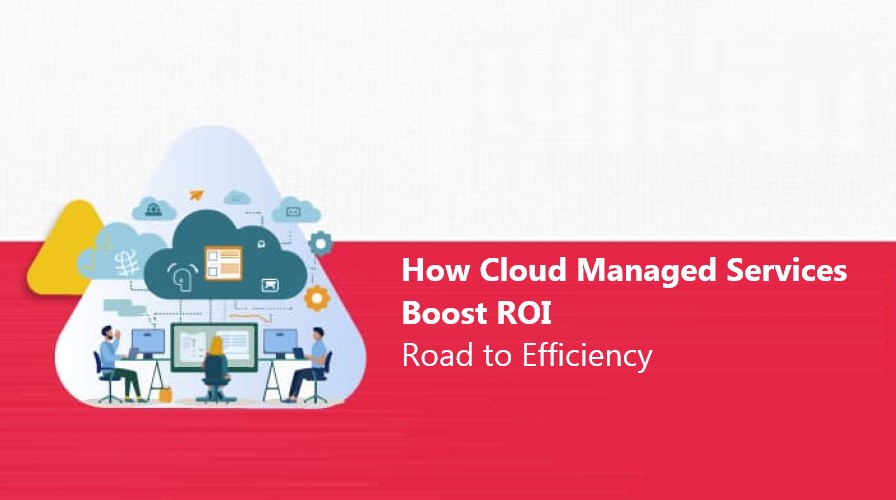Modern IT leaders understand the cost and effort involved in deploying and maintaining servers on their premises. Not surprisingly, many of them turn to cloud managed services to eliminate the upfront expenses of running physical data centers. Managed cloud services offer many benefits. First, cloud service providers know how to handle cloud infrastructure well. So, they make sure it is utilized to the fullest and no extra expenses are incurred. These service providers implement robust security measures to protect business data. They also provision computing instances instantly when demand scales. This allows businesses to run their operations seamlessly without ever slowing down.
Unfortunately, most of these organizations do not understand the costs associated with the cloud. This is primarily because cloud pricing models have become increasingly complex with time. Cloud managed services typically follow a pay-as-you-go pricing model where payment has to be made only for the resources chosen. These resources are seldom used completely, while businesses are fully charged.
Often, IT teams have little idea of how many servers or how much storage capacity they need. They inadvertently overprovision cloud resources, leading to underutilized capacity. Sometimes, cloud resources are left running even when they aren’t needed any longer. The result? Businesses end up spending much more than they planned. If not kept under control, these costs eat into their IT budgets.
To avoid such expenses, businesses should put in place strategies that optimize their cloud spending. We will discuss some of these in this blog.
How to Optimize Cloud ROI: Key Strategies and Best Practices
1) Understand Cloud Pricing and Billing: Cloud pricing is often difficult to understand given the number of variables involved. IT teams should consider breaking down and reviewing their cloud bills to analyze which services incur the highest costs. Charges for computing, storage, and database services should be studied separately. This way, businesses can control their expenses and avoid paying for unnecessary resources.
2) Establish a Budget: Unless they set up a budget for the cloud, businesses may not be able to monitor their costs. To begin with, they should facilitate discussions between IT and finance teams where cloud resource requirements can be estimated based on past usage patterns and upcoming projects. On the basis of these discussions, a monthly cloud budget should be created.
3) Implement Tools for Underutilized Resources: All too often, IT teams sign up for more instances than they actually need. In some cases, they forget to shut down resources when their task gets done. They may be charged for these unused resources, which means they pay for much more than they consume.
Cloud monitoring tools help tackle the problem. These tools provide visibility into the cloud environment, so businesses are able to track if resources are lying idle or if any service is underutilized. This ensures greater control over cloud costs.
4) Right size Services: It is possible for businesses to assess the performance and capacity requirements of their workloads and align them with the right instance type and size. This practice, called rightsizing, allows companies to eliminate unnecessary cloud resources without compromising capacity. For example, a memory-optimized instance may be running an application requiring high processing power. Using rightsizing, it can be matched with a compute-optimized instance.
5) Use Reserved and Spot Instances: Managed cloud service providers offer discounts on certain services to help businesses cut back on their cloud costs. There are pre-paid services like reserved instances where the customer gets a discount if they commit to using a specific instance for 1-3 years. With reserved instances, it is possible to achieve up to 72% cost savings. The downside to using these instances is that they are suitable for predictable workloads only.
Contrary to reserved instances are spot instances which are available through auctions when a cloud vendor sells their leftover inventory. With spot instances, businesses may enjoy up to 90% discounts on regular prices. That said, spot instances come with several limitations.
First, it is impossible to predict if or when a spot instance will become available. Then these sell out quickly during auctions, so no one can count on them for running critical workloads. Spot instances are suited for non-critical workloads that can stand interruption.
6) Choose Cloud-Native Design: Today, it is possible to move any kind of application or workload to the cloud. Even legacy applications can be ‘lifted and shifted’ to a cloud environment with little to no modifications. But we need to remember that legacy applications were never designed for the cloud. So, businesses may not be able to use cloud resources efficiently, and this may increase their operational costs.
To realize the full benefits of the cloud, cloud-native apps are required. With cloud-native applications, businesses can implement different cost optimization measures and reduce their cloud spending to a significant degree.
7) Minimize Data Transfer Fees: Cloud managed service providers charge users for transferring data between different availability zones or regions or from one cloud service to another. Data coming into the cloud or moving out of the cloud also incurs a fee.
Businesses can reduce their cloud costs by restricting data transfers and moving data only when necessary. So, if an organization is regularly moving data from an on-premises application to the cloud, it may consider shifting the application to the cloud. Sometimes, multiple departments move the same data independently to the cloud, raising data transfer costs. Such a situation calls for a change in data management practices.
8) Educate Stakeholders on Cost Optimization: In addition to the strategies described above, businesses should endeavor to create awareness around cost optimization best practices. Tech leaders may consider building a team comprising individuals from IT, operations, and finance. This team can be allocated the task of establishing processes and frameworks to monitor and control cloud costs across different departments. They may also conduct training sessions to educate stakeholders on cost management tools and best practices.
Conclusion
Cloud managed services provide several advantages in the form of enhanced scalability, high availability, and improved business performance. That said, without proper preparation, businesses may spend far more on the cloud than they planned. It is, therefore, important that they gain an in-depth understanding of the costs involved before kickstarting their cloud journey. By studying cloud pricing structure, setting up a cloud budget, and implementing cloud-native designs, businesses can ensure a high ROI.




